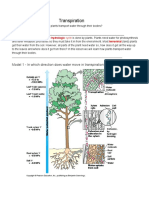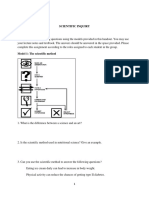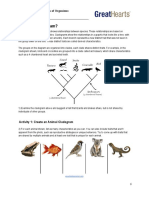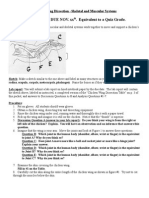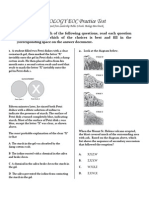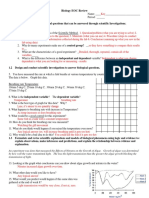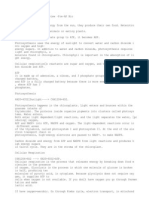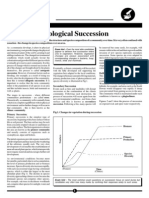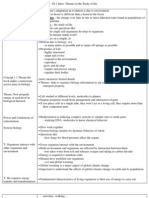Cell Division Lab
Uploaded by
DoctorzoCell Division Lab
Uploaded by
DoctorzoCell Division / Cellular Reproduction
The purpose of this lab is to assist you in learning about cellular division which
includes the cell cycle and mitosis. You will learn how the process is supposed to
take place in normal cells then how the process is altered in cancerous cells.
You will go to the following website: http://glencoe.mcgraw-
hill.com/sites/dl/free/0078757134/383933/BL_23.html
You will follow the instructions and work through the simulation as instructed in the
lab.
As you perform the simulation, you will record your results in the table below (in
another color font).
Once you have completed the lab activity and the table, you will answer the
remaining journal questions below. Please be sure to confer with your textbook and
lecture notes. Please answer all questions in another color font.
Save your file as .doc or .docx and upload it into eCampus in the proper lab section
for grading. Do NOT copy and paste it into the text box on eCampus.
Number of cells in each phase
of cell cycle
% of % of
Interpha Prophas Metapha Anaphas Telophas
cells cells at
se e se e e
dividing rest
Normal
lung 19 1 0 0 0 5 95
Cancerou
s lung 16 0 2 1 1 20 80
Normal
stomach 16 1 1 0 2 20 90
Cancerou
s 14 2 1 1 2 30 65
stomach
Normal
ovary 19 0 0 1 0 5 95
Cancerou
s ovary 12 2 1 2 3 40 60
%cells dividing = PMAT/total cells; % cells at rest = interphase/total cells
Journal Questions:
1. What are the 3 phases that occur during interphase. Explain each stage.
G1(Gap 1), in which the cell grows and functions normally. During this time, a
lot of protein synthesis occurs and the cell grows (to about double its original size) - more
organelles are produced and increasing the volume of the cytoplasm. If the cell is not to
divide again, it will remain in this phase.
Synthesis (S), in which the cell duplicates its DNA (via semi-conservative replication). During S
phase, the centrosome is also duplicated.
G2 (Gap 2), in which the cell resumes its growth in preparation for mitosis.
Additionally some cells which do not divide often or ever, enter a stage called G0 (Gap
zero), which is either a stage separate from interphase or an extended G1 phase which
follows the restriction point, a cell cycle checkpoint found at the end of G1.
The duration of time spent in interphase and in each stage of interphase is variable and depends
on both the type of cell and the species of organism it belongs to. Most cells adults mammals
spend about 20 hours in interphase, this accounts for about 90% of the total time involved in cell
division (1).
2. List 2 distinguishing characteristics of each stage of the cell cycle
(Interphase, prophase, metaphase, anaphase, & telophase).
During prophase the chromosomes become visible and during prophase, the parent cell
chromosomes which were duplicated during S phase condense and become thousands of
times more compact than they were during interphase.
During metaphase, the centrosomes are at opposite poles of the cell. The chromosomes,
now at their most highly coiled and condensed, become arranged on a plane equidistant from the
two poles called the metaphase plate.
During anaphase replicated chromosomes are split and the daughter chromatids are
moved to opposite poles of the cell.
During telophase, Chromosome sets assemble at opposite poles, a nuclear envelope
reforms around each set, and cytokinesis usually follows.
3. Based on your data and observations, what are some of the differences
between normal cells and cancer cells?
Based on my data and observations, some of the differences between normal cells and cancerous
cells, are that cancerous cells tend to be more in telophase, and that normal cells tend to be more
at rest in telophase.
4. Which type of cancer shows the most aggressive growth? Explain.
Ovarian cancer shows the most aggressive growth. Compared to the other organs, cell
division from normal to cancerous had the highest increase. The cells in ovarian cancer increased
from 15% to 40%, which is a 25% increase. Lung cancer had a 5% increase, and stomach cancer
had a 20% increase of dividing cells when going from normal to cancerous.
You might also like
- I. A New Diet: Table 1.the Biological Effects of Insulin100% (1)I. A New Diet: Table 1.the Biological Effects of Insulin9 pages
- The Complete Biomonster Vocabulary Reference Guide100% (1)The Complete Biomonster Vocabulary Reference Guide26 pages
- Kami Export - Juan Arellano - Nature of Science Recap by Amoeba SistersNo ratings yetKami Export - Juan Arellano - Nature of Science Recap by Amoeba Sisters2 pages
- How Do Substances Move in and Out of Cells?: Chapter 3.4 - Membrane Structure and Function Why?No ratings yetHow Do Substances Move in and Out of Cells?: Chapter 3.4 - Membrane Structure and Function Why?5 pages
- Names: Section: Date:: Animal Cell ColoringNo ratings yetNames: Section: Date:: Animal Cell Coloring2 pages
- Guided Group Learning: Drawing and Interpreting Cladograms: Unit 02No ratings yetGuided Group Learning: Drawing and Interpreting Cladograms: Unit 026 pages
- Evidence For The Theory of Evolution (CER) HOT Lab100% (1)Evidence For The Theory of Evolution (CER) HOT Lab13 pages
- Video Recap of Cell Transport by Amoeba Sisters0% (4)Video Recap of Cell Transport by Amoeba Sisters2 pages
- PLTW Biomedical Science Pathway Student Flyer (PVHS 2022-23)No ratings yetPLTW Biomedical Science Pathway Student Flyer (PVHS 2022-23)1 page
- Directed Study - Day 2 - Pyramids Graphic OrganizerNo ratings yetDirected Study - Day 2 - Pyramids Graphic Organizer2 pages
- 1.1 The Study of Life 1.1 What Is Science?No ratings yet1.1 The Study of Life 1.1 What Is Science?10 pages
- Unit 1: Scientific Investigation Biology I Daysheet 6: Biology Pre-Assessment BellringerNo ratings yetUnit 1: Scientific Investigation Biology I Daysheet 6: Biology Pre-Assessment Bellringer6 pages
- Entire Lab Report Due Nov. XX - Equivalent To A Quiz GradeNo ratings yetEntire Lab Report Due Nov. XX - Equivalent To A Quiz Grade5 pages
- Does A Cladogram Reveal Evolutionary Relationships?No ratings yetDoes A Cladogram Reveal Evolutionary Relationships?2 pages
- 08 Lion Elephant Energy From MacromoleculesNo ratings yet08 Lion Elephant Energy From Macromolecules8 pages
- 63383-373662-Video Recap of Mitosis v. 2 by Amoeba SistersNo ratings yet63383-373662-Video Recap of Mitosis v. 2 by Amoeba Sisters2 pages
- Chapter 8, 9, 10 Review - Pre-AP BiologyNo ratings yetChapter 8, 9, 10 Review - Pre-AP Biology3 pages
- 03 Genome Chromosome and Dna Webquest 2 1No ratings yet03 Genome Chromosome and Dna Webquest 2 14 pages
- Vertebrates: Mammals Fish Birds Amphibian ReptilesNo ratings yetVertebrates: Mammals Fish Birds Amphibian Reptiles4 pages
- Science behind Non-specific Science: (For Molecular Biologist & Biotechnologist)From EverandScience behind Non-specific Science: (For Molecular Biologist & Biotechnologist)No ratings yet
- Science Strategies to Increase Student Learning and Motivation in Biology and Life Science Grades 7 Through 12From EverandScience Strategies to Increase Student Learning and Motivation in Biology and Life Science Grades 7 Through 12No ratings yet
- Isolation of Glycogen: Chem 29 Experiment 8No ratings yetIsolation of Glycogen: Chem 29 Experiment 830 pages
- Midterm Examination in BIOLOGY I. Multiple ChoiceNo ratings yetMidterm Examination in BIOLOGY I. Multiple Choice6 pages
- DNA Fingerprinting: Presented by Pranab Borah Department of Herbal Science & Technology ADP College, NagaonNo ratings yetDNA Fingerprinting: Presented by Pranab Borah Department of Herbal Science & Technology ADP College, Nagaon30 pages
- Cancer Drug Discovery - Science and History-Springer Netherlands (Libro-2016)No ratings yetCancer Drug Discovery - Science and History-Springer Netherlands (Libro-2016)286 pages
- 3 Improved Strategies For CRISPR-Cas12-based Nucleic Acids DetectionNo ratings yet3 Improved Strategies For CRISPR-Cas12-based Nucleic Acids Detection9 pages
- The Bacterial RecA Protein and Recombinationlal Dna Repair of Stalled Replication ForksNo ratings yetThe Bacterial RecA Protein and Recombinationlal Dna Repair of Stalled Replication Forks32 pages
- IIB NOTES- Cell Cycle and Cell DivisionNo ratings yetIIB NOTES- Cell Cycle and Cell Division25 pages
- Instant Download Enzymes. A Practical Introduction to Structure, Mechanism, and Data Analysis 3rd Edition Robert A. Copeland PDF All Chapters100% (5)Instant Download Enzymes. A Practical Introduction to Structure, Mechanism, and Data Analysis 3rd Edition Robert A. Copeland PDF All Chapters76 pages

